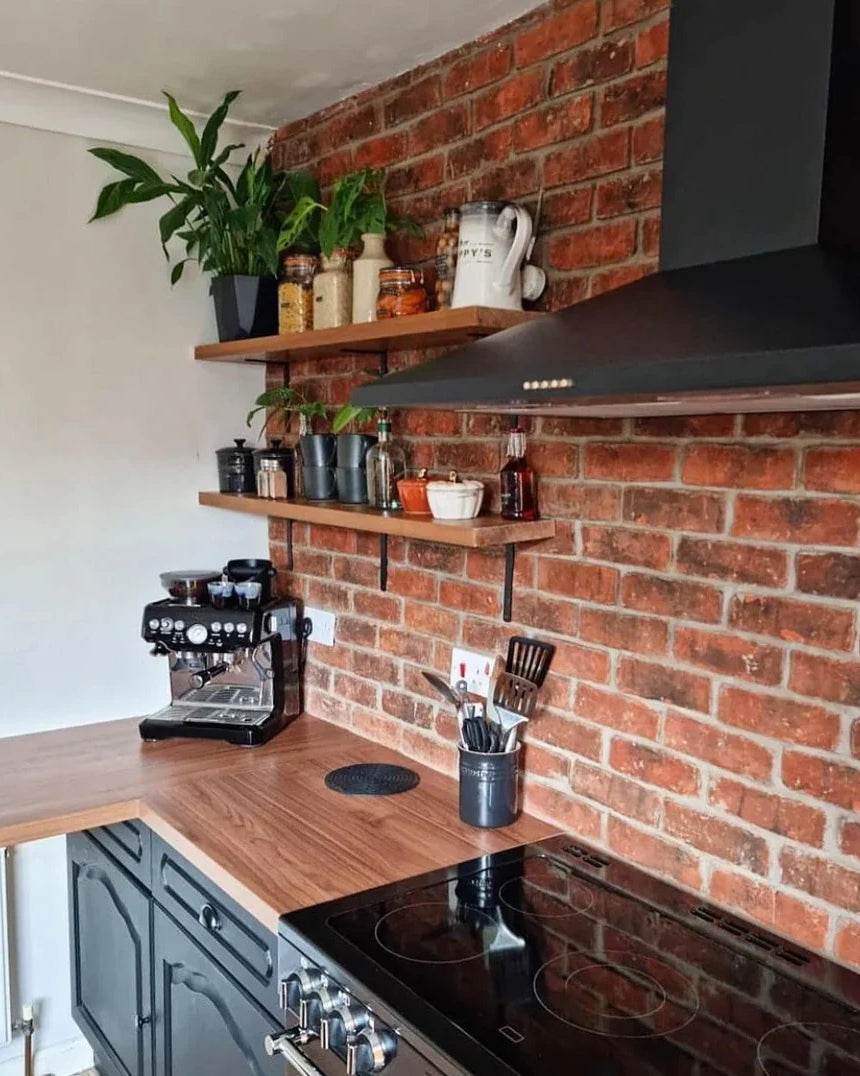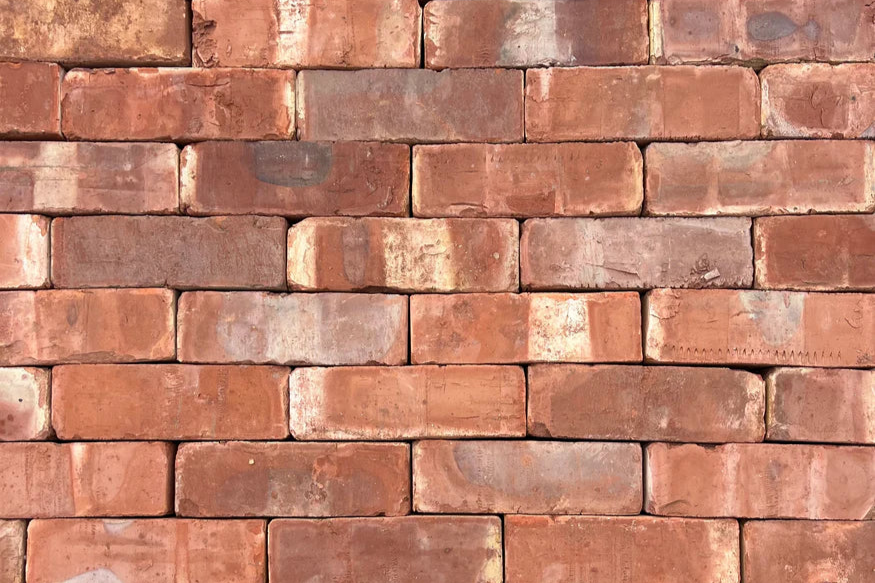In many cases of brick sourcing, the desired scenario is to find a readily available brick perfectly suited to your extension, renovation or new build project. However each building project is unique and you may come across occasions where it can problematic finding a suitable brick.
That's why here at Heritage Brick Company we offer a unique in-house bespoke brick blending and weathering service to create tailor-made solutions to match old brickwork. Our core range of Heritage Bricks can weathered and / or blended to create an unlimited combinations of designs until the right match is found.
How Brick Weathering can help?

Bespoke Blends
Bespoke brick blends allow you to select two or more brick types and merge them to create a new bespoke combination of bricks. Different brick colours or textures can be mixed in varying percentages and are carefully hand-picked and packed to ensure they are perfectly tailored to your project requirements.

Existing Brick Tinting
Brick tinting provides the perfect remedy for blending newer bricks and mortar indistinguishably with original brickwork when a suitable match isn’t available or remedial work is required on site after construction.

Brick Weathering
If you are close by or wish to see our full range, why not come and visit us at our bespoke Brick Centre? and take samples away free of charge.
How to Enquire?
We simply require a good quality image of existing brickwork to generate a blend or weathered match, however on some occasions we may need to send one of our experts to view the site.
Blending and weathering our bricks is often a core element of our free brick matching service. Simply fill in our brick match form and upload your images.
We specialise in providing solutions to problems associated with sourcing aged or reclaimed bricks and strive to offer a perfect match to existing brickwork every time.
Key Benefits
Tailor made solutions for bespoke for each individually enquiry.
Unlimited combinations of brick designs and colours until the right match is found.
Authentic match to old weathered brickwork and styles across the UK.
Permanent solution - Providing tinting products are applied in accordance with the manufacturer guidance, brick tinting offers a permanent finish which will weather naturally with existing masonry
Breathable - Tints do not seal the face of the brickwork which is vital to avoid frost damage due to trapped moisture
Bespoke Colour Correction - The colour of masonry can be altered with coloured brick dyes
Experienced, knowledgeable and friendly team on hand to help
Gradual Weathering Options - Can be diluted with water to suit particular application requirements and give an aged appearance without hiding original features
FAQs - Bespoke Brick Blending & Weathering
Why do bricks weather?
Bricks weather over time due to a number of factors, including:
- Moisture
Bricks are porous, which allows water to seep in and break down the brick. This can happen through cracks or pores in the brick.
- Freeze-thaw cycles
Water that gets into a brick can expand when it freezes, causing the brick to crack.
- Salt crystallization
When a saline solution gets into a brick, it can expand and crystallize, causing damage.
- Efflorescence
This occurs when soluble salts in the brick or mortar combine with water and dissolve. As the brick dries, the moisture is drawn to the surface, leaving salt deposits behind.
- Incorrect installation
Using the wrong type of brick for a location's weather conditions can cause damage.
- Poor construction
Poor construction or using salvaged bricks can cause bricks to spall faster.
- Mortar
The type of mortar used can also affect brickwork. For example, using cement mortar over a more breathable mortar can cause moisture to try to escape through the brick face, leading to spalling.
To prevent efflorescence, you can store finished bricks wrapped and off the ground to prevent moisture absorption. You can also use low alkali cement in mortar and grout to minimize efflorescence.
How to stop bricks from weathering?
Here are some ways to prevent bricks from weathering:
- Apply a breathable sealant
A breathable masonry sealant can repel moisture and liquids, and protect against UV damage.
- Apply a façade cream
A coat of façade cream can protect unpainted brickwork from water penetration for up to 30 years.
- Apply an exterior wall coating
A high-quality exterior wall coating can create a waterproof barrier to protect brickwork from rain and moisture.
- Repoint the mortar
Remove the outer layer of mortar and replace it with fresh mortar to create a firm seal.
- Use low alkali cement
Use low alkali cement in mortar and grout to help keep efflorescence to a minimum.
- Store bricks wrapped and off the ground
Store finished bricks wrapped and off the ground to prevent moisture absorption.
- Use coping stones
Use coping stones that slope both ways to allow rainwater to run off.
Bricks are porous and absorb moisture easily, which can cause them to crumble and deteriorate.
Can you paint bricks?
Yes, you can paint bricks, but there are some things to consider before you do:
- Paint type
Use a breathable paint that's designed for brick. For exterior brick, use a masonry paint that can withstand wind and rain.
- Preparation
Before painting, clean the brick with a garden hose or pressure washer to remove dirt, mildew, and debris. You can also use muriatic acid to remove salt deposits called efflorescence. Fill any cracks with a paintable caulk.
- Application
Use a roller with a medium to long pile to apply the primer and paint. For the first coat, apply the paint in a vertical motion, making sure to get solid coverage. Apply a second coat.
- Maintenance
Painting brick can add maintenance and make it difficult to return to the original brick finish. Brick is porous and designed to release moisture, but painting it seals in moisture and can cause the brick to erode over time.
Painting brick can be a good way to update the look of a space, but it's not always the best option. You can try other methods to enhance the look of your brick without painting it.
How to match a weathered old brick?
There are a few ways to match weathered old brick, including:
- Tinting
A dye can be applied to the face of the brick to blend it in with the original. The dye penetrates the clay and bonds permanently, weathering at the same rate as the original brick. Tinting can also be applied to brick mortar.
- Staining
If the brick is absorbent, a masonry stain can be used to change its colour.
- Find similar bricks
It may be possible to find bricks with similar shades and textures that will look good next to the old bricks.
- Adjust mortar colour
For small differences, the colour of the mortar can be tweaked to help the bricks blend together.
- Blend colours
More than one brick colour can be blended to match the original wall.
Does brick work have to be sealed?
Not all brickwork needs to be sealed, but if you do seal brick walls - experts recommend re-sealing it around every 5 years, or when the bricks are no longer hydrophobic. Some brands claim that their masonry sealant can last up to 25 years.
How Bespoke Brick Blending can provide an unique solution?
Bespoke brick blends allow you to select two or more brick types and merge them to create a new bespoke combination of bricks. Different brick colours or textures can be mixed in varying percentages and are carefully hand-picked and packed to ensure they are perfectly tailored to your project requirements.
Key Advantages
- Tailor made solutions for bespoke for each individually enquiry.
- Unlimited combinations of brick designs and colours until the right match is found.
- Authentic match to old weathered brickwork and styles across the UK.
How Brick Weathering can help match my house brick?
Brick weathering and tinting can help match new bricks to existing brickwork in a number of ways:
- Darkening new bricks - Brick weathering can tone down the colour of new bricks to match older bricks. This can be useful when renovating or working on historic buildings.
- Matching weathered brickwork - Brick tinting can colour match even the most weathered brickwork. This can make new brickwork indistinguishable from the original.
- Aging new bricks - Liquid weather products can give new bricks an aged look. This can be more cost effective than buying authentic bricks.
- Custom weathering - Some brick suppliers offer custom weathering solutions to age and weather bricks to suit a project.
When matching bricks, it's important to consider other factors, including:
- Size: Brick sizes have changed over time, so it's important to consider the size of the original bricks.
- Colour: The colour of a brick depends on the raw materials used to make it.
- Texture: The texture of the original bricks should be considered.
- Reclaimed bricks: Reclaimed bricks can be a good way to find an exact match, especially for older buildings.
How to get a Free Brick Match?
There are several ways that you can get a free brick matching services, including:
- By Email
- Filling in our online form
- Project Site Visit
- Visit our Brick Showroom
The Brickyards provide a free and easy brick matching service in just a few simple steps. Our team of friendly and knowledgeable staff offer a comprehensive service delivered with the most extensive knowledge in the area.
Can I order Brick Samples?
Order via Product Page
On the specific product page, to the right of the product image there is an 'Order Sample' Button. Click the button to order your sample online.
Order via Email
Simply email our sales team your project requirements and specific product you wish to order a sample.
Visit Us
If you are close by or wish to see our full range, why not come and visit us at our bespoke Brick Centre? and take samples away free of charge.
Our Story
Heritage Brick Company is a family-run brick supplier based in Yorkshire, that supplies a broad range of new metric and imperial sized bricks made to match British Masonry Traditions. Best known for its vast selection of high-quality products and exceptional service.
Download the Brick Catalogue
Our catalogue of curated traditional clay bricks contains the latest collection of colours and textures, produced using modern machinery and traditional manufacturing methods.

























